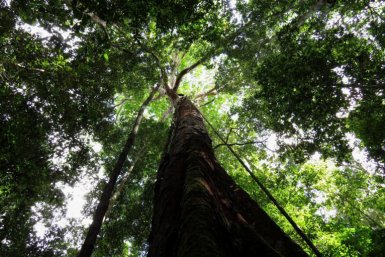Global Trend: Tropical Rainforests Losing Resilience Worldwide
Tropical rainforests hold a wealth of biodiversity but are globally approaching a critical point. The drastic decline is happening faster than expected, concludes an international research team. The team includes biologist Hans ter Steege, affiliated with Utrecht University and the Naturalis Biodiversity Center.

A team of researchers, including tree expert Hans ter Steege of Naturalis Biodiversity Center and Utrecht University, has provided new insights into the status of tropical forests worldwide. The team identified all tree species found in tropical rainforests, their distribution, and applied new calculations to these data. The results, published in the journals Nature and Science, collectively answer the question: how are tropical rainforests faring?
Understanding forests better
Tropical forests such as those in Africa, the Amazon, and Southeast Asia are hotspots of biodiversity. Researchers wonder why these areas were able to develop this way. What do these forests have in common, serving as a home to millions of species for centuries? Ter Steege and his team pondered these questions. They discovered that just a small number of common species contribute to half of the biodiversity in these forests.
“Despite differences in geography, climate conditions, and history, we find the same type of distribution of common species in these different forests”
“But despite differences in geography, climate conditions, and history, we find the same distribution of common species in these different forests,” says Ter Steege.
Common and robust species
The exact reasons for this are still a mystery. “Likely, the very common species are more resistant to insects and fungi than rare species, allowing them to reach higher densities,” says Ter Steege. Although researchers don’t fully understand how this distribution occurred, it helps them better understand and protect the biodiversity of forests.
Underestimated decline
According to Ter Steege, this protection is urgently needed. Recent research, in which Ter Steege participated, showed that only 15 percent of the Atlantic Forest in Brazil remains. The rest has been cleared and damaged due to significant population pressure and deforestation in the country.
“As a result, more than 80 percent of the tree species unique to the Atlantic Forest in Brazil are threatened with extinction,” says biologist Renato Lima, who led the research.
When the researchers included population size in their calculations, they made the alarming discovery that many more species are threatened than previously thought. “It turns out that almost 5000 tree species found in the Atlantic Forest are threatened with extinction,” says Lima. “And thirteen species, found exclusively there, may have become extinct.”

Decline at multiple locations
Unfortunately, this decline is likely happening in multiple locations. “Our forecasts suggest that between 35 and 50 percent of tree species on earth could be threatened solely by deforestation,” Lima concludes. With the new models developed by the research team, the threat level of thousands of species can now be assessed on a large scale.
“This is essential,” says Ter Steege, “because the findings still underestimate the extent of future decline.” The research only considers past threats, such as deforestation, and does not account for future threats, such as climate change, which could further accelerate species extinction risks.
Stretching the limits
This risk is confirmed in earlier research on the tropical rainforests of the Amazon, which did consider these future influences. For 65 million years, the resilient forests of the Amazon served as a buffer against climate change. That seems to be changing now. The research proves that the resilience of the once resilient forests of the Amazon is waning, putting them at a dangerous tipping point.
Rainforests turning into savannas
“We estimate that by 2050, 10 to 47 percent of the forests in the Amazon will be exposed to such disturbances that the current ecosystem will collapse, leading to even more dramatic regional climate change,” says Ter Steege. According to the researcher, the rainforest will then turn into damaged patches of forest dominated mainly by a single species, such as bamboo. Another possibility is that it will turn into a plain savanna.
Firstly, deforestation and forest degradation must stop. Additionally, we need to promote forest restoration in affected areas
Restoring the Forest Balance
We can turn the tide, says Ter Steege. “To restore the resilience of tropical rainforests, global efforts must halt greenhouse gas emissions. Only then we can limit global warming.”
Local efforts can also help restore the forest balance. Ter Steege: “Firstly, deforestation and forest degradation must stop. Additionally, we need to promote forest restoration in affected areas.” This can be achieved, for example, by expanding protected and indigenous habitats.
The situation is critical, and action is urgently needed
“The situation is critical, and action is urgently needed,” says Ter Steege. “Fortunately, with a new government in Brazil, this seems feasible. President Lula has committed to a zero-deforestation policy by 2030, halting illegal deforestation in the Amazon.” According to Ter Steege, this would not only help biodiversity, it will also benefit agriculture in Brazil and Bolivia, as the forests sustain a constant flow of rain necessary for crops.

